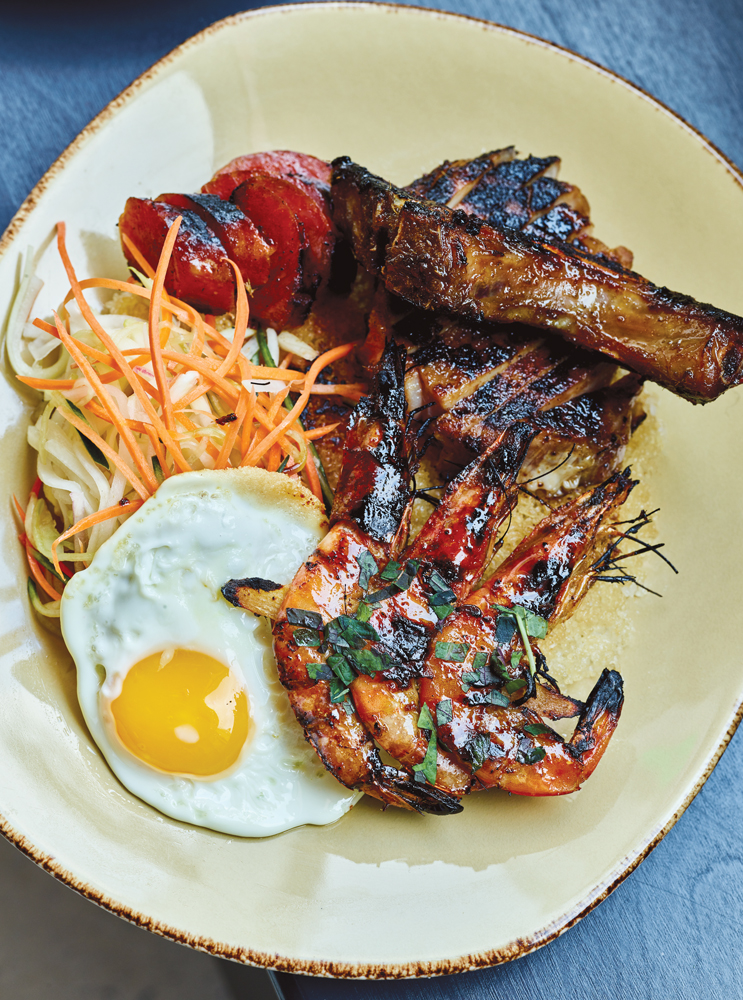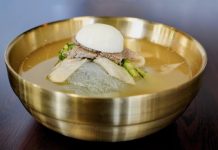
I left my suburban Los Angeles hometown in 2007 just as Echo Park was in the throes of transforming from an East Hollywood barrio into a hipster haven. A decade later, looking at DetroitтАЩs Southwest side, I see much of the same trappings: a longtime Mexican-American section of town that thrived on immigrant entrepreneurship now being overrun by new money and development.
When I first heard about Flowers of Vietnam тАФ a former coney island slinging pho one night a week тАФ I was relieved to find it didnтАЩt have that icky gentrification feeling. A guy from the neighborhood, owner and chef George Azar, was running the show.
Azar had the culinary chops to suggest he could just as well work his way up the professional ladder in a тАЬbougieтАЭ white tablecloth establishment. Instead, he chose to bring dining excellence тАФ with an unpretentious touch тАФ to his neighbors.
Flowers opened in early 2016 as a Sundays-only eatery inside Vernor Coney Island. Word spread, but folks werenтАЩt exactly sure what to make of it. Was it a popup? A supper club? Was it still a coney? Its only sign was an old-school neon one. The dining room, with the echo of a mostly hip-hop playlist, exuded an air of warmth. Half of the staff was from the neighborhood.

Azar grew up in Detroit, not far from where Flowers now sits. The son of Palestinian immigrants, his upbringing was more informed by his Chicano neighbors, as evidenced by how he sometimes throws out Spanish slang when barking orders.
During summers, he went to stay with an aunt in San Francisco, and was inspired by the Tenderloin neighborhood. That exposed him to a different world outlook, including his first taste of Vietnamese salt and pepper shrimp.
Perhaps that planted a cooking seed. Azar eventually enrolled at Schoolcraft CollegeтАЩs culinary program. Following a rotation of local gigs, including at Forest Grill and the Detroit Athletic Club, he got out of Dodge and cut his teeth in the kitchens of legendary chefs such as Grant Achatz of ChicagoтАЩs Alinea Group and Thomas Keller at the Michelin-star rated Bouchon in Las Vegas.
When Azar returned to Detroit in 2013, he saw signs that his city was beginning to transform, such as when he walked into CorktownтАЩs Astro Coffee shop, and he wanted to be involved in bettering the neighborhood. After a car accident, Azar recuperated by enrolling in the hospitality program at Michigan State University. That year, he landed a job as a тАЬfixerтАЭ for Anthony Bourdain during the TV star chef/authorтАЩs Detroit taping.
Azar was determined to bring something to his hometown that was informed by his admiration for the emotional components of Vietnamese cooking. Whether he had a concrete road map, his intentionality was clear: Flowers was both playful raw energy and refined and chef-driven; part finger-licking, sticky chicken wings and beautifully executed lobster. Traditionally Vietnamese and authentically Azar.

The part-time eatery gained local press, with national media soon chomping at the bit. The story served as a sort of counter-narrative to the trendy eateries gobbling up attention in more gentrified parts of town: a native Detroiter opening a Vietnamese restaurant in his old neighborhood coney.

It became evident Azar needed to kick renovations into gear. Longtime mentor Paul Saginaw (co-founder of ZingermanтАЩs of Ann Arbor) joined as a partner. When Flowers closed to remodel in March 2017, Azar continued his culinary education with a residency under Ren├й Redzepi, when the lauded Danish chef held a Noma pop-up in Mexico.
Azar followed that up with a trip to Vietnam with his core crew to come back with a more personal connection to its culinary traditions.
Flowers of Vietnam reopened in early 2018. The space was designed by architecture firm Et. Al Collaborative (the company behind Selden StandardтАЩs sleek look). An expanded bar exudes industrial coolness. The restrooms, too, are outfitted with ceiling projectors that shine old photos onto the floor.
General Manager and Beverage Director Anna Atanassova has curated a comprehensive wine and drink menu, paying close attention to the herbaceousness of the menuтАЩs produce and salty, fishiness of the proteins by incorporating a number of white wines, rieslings, and rare beers.
Despite the changes, the neighborhood joint vibe remains. A good percentage of the original staff returned. The glow of the coney neon remains, too.

Flowers intentionality has been lovingly maintained, but the question comes up among purists: What of the food? To be clear, the menu is largely shaped around AzarтАЩs appreciation of Vietnamese food. The Korean-fried caramel chicken wings are an example of tradition-meets-inspiration. Azar refined the recipe to achieve the right crisp-to-sauce ratio so the skin doesnтАЩt get soggy under the sweet, slightly nutty and spicy stain-your-fingers glaze.
He pays homage to Vietnamese rau mau (a sort of herbs de Provence) with the papaya salad, which provides a light, refreshing acidity in a sharable dish. Then thereтАЩs tender heads of bok choy saut├йed and swimming in a sweet soy and salt and pepper. ItтАЩs not particularly тАЬVietnamese,тАЭ but still rather flavorful. Some of AzarтАЩs standout dishes are also the most simply-prepared, like the seasonal fish fried enough to crisp the skin but also leave a succulent meat inside, accompanied by banana blossom, tomato, and cilantro-topped black rice. AzarтАЩs childhood salt and pepper shrimp are ever so lightly breaded and highly addictive. The crispy rice, served with a spread of pork chop, Chinese sausage, sugarcane shrimp, and an egg sunny-side up is easily a meal IтАЩd eat for breakfast, lunch, or dinner.

Other dishes include a beautifully plated fried lobster, made up of tender morsels that rest on a bed of translucent vermicelli noodles and accompanied with pickled Chinese ramps and seasonal fruit. Also brilliantly executed is the Bo Tai Chanh, sliced rare beef cut like a carpaccio and accompanied by pomelo oranges and grapefruit, Red Boat salt, a delectable nuac cham sauce, and more rau mau. The Bo Kho тАФ a braised beef featuring a dark gravy layered with a complexity of flavor (with apparent notes of fish sauce) and carrots тАФ hints at VietnamтАЩs French colonialist influence.
The menu is still evolving. The ora king salmon, for example тАФ steamed in a sea bath and served in a banana leaf тАФ displays fine dining ambitions as itтАЩs prepared in a rich lobster essence and kaffir lime. While it comes out incredibly silky, it misses the marks that the red snapper or shrimp capture.
And the pho. Metro Detroit has a decent-sized number of pho shop. Loyal pho followers have strong opinions about that quintessential broth. Azar uses bone broth, offering more of a pronounced beef essence. IтАЩm hopeful that as Flowers gets its legs, the pho will evolve in complexity.
The most creative item on the menu is on the dessert section: Terroirs of Vietnam, inspired by a deconstructed Vietnamese egg coffee. A slab of rich, buttery ice cream sits next to an incredibly rich nougat and an 80 percent cacao тАЬchantillyтАЭ cream so bitter it jolts the senses. Each disparate flavor of the impeccably-plated dish is to be experienced on its own, one decadent bite at a time.
Southwest Detroit is no doubt changing, but spots like Flowers of Vietnam under the care of native Detroiters give me hope that the neighborhood will retain its salt-of-the-earth humbleness.
4430 W. Vernor Hwy., Detroit; 313-554-2085. D Wed.-Sun.
|
| ╠¤ |
|








